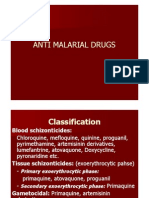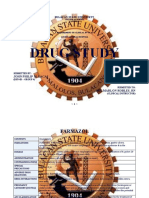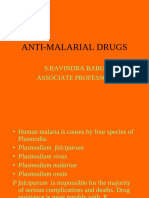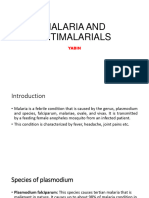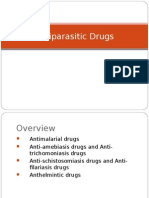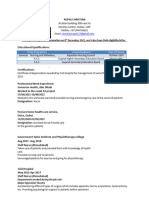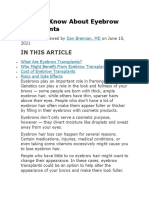0 ratings0% found this document useful (0 votes)
16 views ANTIMALARIALS
ANTIMALARIALS
Uploaded by
ojelomaryAntimalarial drugs
Copyright:
© All Rights Reserved
Available Formats
Download as PPTX, PDF, TXT or read online from Scribd
ANTIMALARIALS
ANTIMALARIALS
Uploaded by
ojelomary0 ratings0% found this document useful (0 votes)
16 views22 pagesAntimalarial drugs
Copyright
© © All Rights Reserved
Available Formats
PPTX, PDF, TXT or read online from Scribd
Share this document
Did you find this document useful?
Is this content inappropriate?
Antimalarial drugs
Copyright:
© All Rights Reserved
Available Formats
Download as PPTX, PDF, TXT or read online from Scribd
Download as pptx, pdf, or txt
0 ratings0% found this document useful (0 votes)
16 views22 pages ANTIMALARIALS
ANTIMALARIALS
Uploaded by
ojelomaryAntimalarial drugs
Copyright:
© All Rights Reserved
Available Formats
Download as PPTX, PDF, TXT or read online from Scribd
Download as pptx, pdf, or txt
You are on page 1of 22
ANTIMALARIAL DRUGS
Anopheles Mosquito
1 Nursing Pharmacology 05:13 PM
ANTIMALARIALS
1. ARTEMISININ and its derivatives
• Artemisinin – Limited to oral use
• Artesunate – oral, IV, IM, rectal
• Artemether – oral, IM, rectal
Combined with drugs such as mefloquine ,
lumefantrine (Coartem), amodiaquine ,
piperaquine (Duo-Cotecxin), and pyronaridine
(Pyramax). =Artemisinin-based Combination
Therapy (ACT)
Mxn: Fast acting blood schizonticide on all species,
kill the parasites-not well known
2 Nursing Pharmacology 05:13 PM
ARTEMISININ……..
Uses: •Standard for RX of uncomplicated P.
falciparum
S/E (fairly well tolerated)
• GIT disturbance (nausea, vomiting,
diarrhea)
• Irreversible neurotoxicity w/ high doses.
• Avoid in pregnancy
NB: WHO discourages monotherapy
3 Nursing Pharmacology 05:13 PM
Artemisia annua plant
4 Nursing Pharmacology 05:13 PM
2. Sulfonamide-pyrimethamine
Pyrimethamine
● Pyrimethamine interferes with tetrahydrofolic
acid synthesis from folic acid - folate needed
to synthesize DNA
Acts slowly against all erythrocytic stage of all
species of plasmodium.
Adm: oral
Elimination: long t1/2 -(allows once a week
dosing)
S/E
GIT irritation
Rashes, itching
Teratogenic in animals (use if benefits
outweigh risk in pregnancy)
Always supplement folic acid if antifolates are
5
used in pregnancy
Nursing Pharmacology 05:13 PM
Sulphonamide-pyrimethamine
Uses:
Malaria prophylaxis e.g. pregnancy
Toxoplasmosis - a parasitic disease caused by
the protozoan Toxoplasma gondii(combined
with sulfadiazine or clindamycin and folic acid)
Examples
FANSIDAR = SULPHADOXINE + PYRIMETHAMINE
METAKELFIN = SULPHALENE + PYRIMETHAMINE
6 Nursing Pharmacology 05:13 PM
3. PROGUANIL
●A slowly acting blood schizonticide against
all 4 forms of plasmodium
Adm: oral & adequately absorbed.
Elimination: t1/2 – long (once daily dosing)
S/E
GIT irritation, Skin rash, Mouth ulcers &
Alopecia
Uses:
Prophylaxis of malaria – (alternative to
mefloquine)
Dose: 2 tabs daily.
7 Nursing Pharmacology 05:13 PM
4. QUININE & QUINIDINE
● Quinine is a natural white crystalline alkaloid
having antipyretic (fever-reducing),
antimalarial, analgesic (painkilling), and
anti-inflammatory properties and a bitter taste
Quinidine is an antimalarial schizonticide and
an antiarrhythmic agent ; it is the isomer of
quinine
MOA: not well known, but rapid blood
schizonticide against all 4 species.
Adm: oral, parenteral
Abs: rapid, impaired by Al3+ containing antacids
Distribution: wide & with extensive protein-
binding hence a loading dose is required.
Elimination:
8 Liver
Nursing Pharmacology
metabolism, renal excretion (NB. Monitor
05:13 PM
9 Nursing Pharmacology 05:13 PM
19th-century illustration of Cinchona calisaya
S/E
1.Cinchonism – a combination of –Tinnitus,
visual disturbance, dizziness, headache, nausea
Serious S/E
2. Audio-visual disturbance
3. Hypersensitivity reactions
4. Hypoglycemia (stimulates insulin release, felt
most in pregnancy)
5.GIT irritation
6. Hematological abnormalities – hemolysis,
leukopenia, agranulocytosis, thrombocytopenia
7. Thrombophlebitis at site of infusion
8. Mild uterine contractions (esp. 3rd trimester)
9. Hypotension – with rapid infusion
10 Nursing Pharmacology 05:13 PM
Quinine……
Precautions/ avoid in:
Severe cinchonism (discontinue therapy)
Auditory or visual problems
Presence of myasthenia gravis
Cardiac abnormalities
Patients who have recently received
mefloquine
D/I
Mefloquine (increases quinine toxicity) – do
not co-administer
Quinine raises the plasma conc. of Warfarin
and Digoxin
11 Nursing Pharmacology 05:13 PM
Quinine:
Uses:
1. Severe falciparum malaria (DOC,
parenteral)
2. Babesiosis (Babesia microti) Babesiosis is
a malaria-like parasitic disease caused by
infection with Babesia- DOC in combination
with clindamycin
3. Nocturnal leg cramps
Dose:
P.O= 600mg TDS *1/52
IV infusion: loading with 20mg/kg(max.1.4g)
then 10mg/kg(max.700mg) TDS over 4
hours.
NB: When patient can swallow, switch to oral
12 drug
Nursingto complete 7 days therapy.
Pharmacology 05:13 PM
5. MEFLOQUINE
●Strong blood schizonticide
Adm: oral (produces severe local irritation with
parenteral use)
Absorption: good but slow
Distribution: extensively in tissues
Elimination: t1/2- long
• Some metabolism, Biliary excretion mainly.
S/E
●GIT irritation, Sleep disorders
●Behavioral (Neuropsychiatric) disturbance
●Hepatic damage, arrhytmias
●Leukopenia and thrombocytopenia
13 Nursing Pharmacology 05:13 PM
MEFLOQUINE
C/I – in the presence or History of
1.Cardiac conduction defects
2. Epilepsy
3. Neuropsychiatric disorders
4. Hypersensitivity (to related drugs) e.g.
Quinine, quinidine or halofantrine (do not co-
administer)
Uses:
1.Chemoprophylaxis=1 tab(250mg) weekly.
● NB.co-administer with primaquine for
radical cure of P. vivax & ovale)
14 Nursing Pharmacology 05:13 PM
6. HALOFANTRINE
●Rapid blood schizonticide against all 4 species
Administration: oral
Absorption: variable, enhanced with meals
(especialy fatty foods)- but take on empty
stomach to avoid high plasma conc.
associated with toxicities
S/E
• GIT irritation • Headache, cough
• Pruritus, rash • Mild hepatic damage
• Cardiac conduction defects – arrhythmias,
death
• Embryotoxic in animals
15 Nursing Pharmacology 05:13 PM
HALOFANTRINE……
C/I
Persons with cardiac conduction defects
Persons recently on mefloquine
Pregnancy
Uses:
Treatment of falciparum malaria (NOT for
chemoprophylaxis)
Dose: >40kg= 500mg TDS- QID (max 6 tabs)
<40kg=8mg/kg QID( max 24mg/kg).
16 Nursing Pharmacology 05:13 PM
8. PRIMAQUINE
The only drug against hypnozoites (dormant
state in liver. It is also gametocidal
Adm: oral (NEVER give parenteral –lead to
severe hypotension)
Abs: adequate
S/E
GIT distress - take w/ food
Hemolysis and methemoglobinemia esp in
G6PDH deficiency
Serious S/E
Hematological abnormalities – leucopenia,
agranulocytosis,
Cardiac arrhythmias
17 Nursing Pharmacology 05:13 PM
PRIMAQUINE…..
C/I
Those at risk of granulocytopenia,
methemoglobinemia (Methemoglobin is an
oxidized form of hemoglobin that has a
decreased affinity for oxygen).
In pregnancy
Uses:
Radical cure of P. vivax & ovale infections (add
a schizonticide too)
Terminal prophylaxis (after end of travel) to
eradicate any liver forms
Alternative for mild Pneumocystis jiroveci
infection (along w/ clindamycin)
Dose: 15mg OD (PO) for 2-3 weeks.
18 Nursing Pharmacology 05:13 PM
9. AMODIAQUINE (Camoquin, Flavoquine)
The mode of action of amodiaquine has not
yet been determined.
Adm: oral
S/E
•Agranulocytosis, hepatotoxic, peripheral
neuropathy, visual disturbances.
Aminoquinolines depress cardiac muscle,
impair cardiac conductivity, and produce
vasodilatation with resultant hypotension.
Uses:
•Sensitive strains of malaria
•(don’t use for prophylaxis due to its S/E)
Dose: 600mg (PO) OD X 3/7
19 Nursing Pharmacology 05:13 PM
10. Antibacterials used as antimalarials –
E.g.Tetracycline, doxycycline, clindamycin
Are SLOW schizonticides– hence never use
alone for treatment.
Uses:
Treatment of falciparum malaria in conjunction
with other drugs e.g. quinine
Chemoprophylaxis of malaria (Doxycycline).
20 Nursing Pharmacology 05:13 PM
WHO guidelines
Artemisinin-based combination therapies
(ACTs) are the recommended treatments for
uncomplicated P. falciparum malaria.
Severe malaria is a medical emergency.
For adults, artesunate IV or IM: OR
artemether or quinine is an acceptable
alternative if parenteral artesunate is not
available.
Give parenteral antimalarials in the treatment
of severe malaria for a minimum of 24 h
21 Nursing Pharmacology 05:13 PM
The End….
Thank
you!!
22 Nursing Pharmacology 05:13 PM
You might also like
- NCP Acute Pain (HTN Crisis)Document3 pagesNCP Acute Pain (HTN Crisis)Jenny AjocNo ratings yet
- EICC VAP AuditOperationsManualv5 01 Ch07 PDFDocument24 pagesEICC VAP AuditOperationsManualv5 01 Ch07 PDFYusuf Bayu AjiNo ratings yet
- The 1200 Calorie Indian Diet Plan For Healthy Weight LossDocument18 pagesThe 1200 Calorie Indian Diet Plan For Healthy Weight LossIlias0% (1)
- Nationwide Fight Against CPSDocument4 pagesNationwide Fight Against CPSCarol Hiller83% (6)
- Antimalarials DrugsDocument27 pagesAntimalarials DrugsAlishba MushtaqNo ratings yet
- Antimalarial Drugs: DR Vikasendu Agarwal LLRM Medical College MeerutDocument36 pagesAntimalarial Drugs: DR Vikasendu Agarwal LLRM Medical College MeerutVikasendu AgarwalNo ratings yet
- 12 MalariaDocument61 pages12 MalariaMewael TesfamichaelNo ratings yet
- MalariaDocument45 pagesMalariaSiya PatelNo ratings yet
- Antimalarial DrugsDocument6 pagesAntimalarial Drugsrajendra kumar SwamiNo ratings yet
- Antimalarialdrugs 200419172207Document31 pagesAntimalarialdrugs 200419172207hamnahameed21No ratings yet
- 9 - Antiprotozoal DrugsDocument29 pages9 - Antiprotozoal Drugsمهند الرحيليNo ratings yet
- Antimalarial DrugsDocument49 pagesAntimalarial DrugsMalueth Angui50% (2)
- Anti Malarial DrugsDocument42 pagesAnti Malarial DrugsSaurabh GautamNo ratings yet
- 'Mbbs Lecture Note Malaria - pptx2021-1Document56 pages'Mbbs Lecture Note Malaria - pptx2021-1Noah OlumideNo ratings yet
- Antiprotozoals Part IDocument46 pagesAntiprotozoals Part IAYO NELSONNo ratings yet
- Antimalarial Agents@DrSKMDocument62 pagesAntimalarial Agents@DrSKMAyush Kumar MishraNo ratings yet
- Anti-Malarial DrugsDocument58 pagesAnti-Malarial Drugs88AKKNo ratings yet
- Anti ProtozoansDocument39 pagesAnti ProtozoansIsmail IbrahimNo ratings yet
- Anti Malarial DrugsDocument51 pagesAnti Malarial Drugsn.nayyabazharNo ratings yet
- Chemotherapy For Malaria - 1Document21 pagesChemotherapy For Malaria - 1hariniNo ratings yet
- Antimalarials 2017Document46 pagesAntimalarials 2017Ezra OndeyoNo ratings yet
- Spring 2023 DrugsDocument3 pagesSpring 2023 Drugshqqbx9dy65No ratings yet
- ANTIMALARIAL DrugsDocument25 pagesANTIMALARIAL DrugsMANAS ChhapoliyaNo ratings yet
- Antimalarial DrugsDocument45 pagesAntimalarial DrugsDeribe BekeleNo ratings yet
- Plaquenil®: Hydroxychloroquine Sulfate, UspDocument8 pagesPlaquenil®: Hydroxychloroquine Sulfate, UspAvinash KumbharNo ratings yet
- Anti Malarial DrugsDocument39 pagesAnti Malarial DrugsbasharalsabireNo ratings yet
- Transfer of Drugs Across The Placenta and Breast. Influence of Pregnancy On Drug Dose Adverse Effects of Drugs in PregnancyDocument23 pagesTransfer of Drugs Across The Placenta and Breast. Influence of Pregnancy On Drug Dose Adverse Effects of Drugs in PregnancyJes CmtNo ratings yet
- Afb5 - 1. Antimalarials MedicalDocument63 pagesAfb5 - 1. Antimalarials MedicalAx D98No ratings yet
- Drug Study Batch 1Document17 pagesDrug Study Batch 1John Philip M. Lacas RNNo ratings yet
- Antimalarial Agents 2023Document41 pagesAntimalarial Agents 2023Christine AyambaNo ratings yet
- XIV. Antimicrobial Drugs (D, E, F, G), ZI-WA, AY18-19Document64 pagesXIV. Antimicrobial Drugs (D, E, F, G), ZI-WA, AY18-19Hala Al-siyabiNo ratings yet
- S 022 LBLDocument4 pagesS 022 LBLkutafoaklilu5No ratings yet
- Cyclophosphamide Tablets: Drug MonographDocument2 pagesCyclophosphamide Tablets: Drug MonographShane PangilinanNo ratings yet
- Antibiotic Penicillin: Ampicillin Ampicillin Sodium AmpicillinDocument3 pagesAntibiotic Penicillin: Ampicillin Ampicillin Sodium AmpicillinMaria Delia SalvadoNo ratings yet
- AntiepilepticDocument4 pagesAntiepilepticWan TokNo ratings yet
- Drug StudyDocument7 pagesDrug StudysarahtotNo ratings yet
- Drug Study HydralazineDocument10 pagesDrug Study HydralazineLuige AvilaNo ratings yet
- Complete Albendazole Information From DrugsDocument4 pagesComplete Albendazole Information From DrugselephantynoseNo ratings yet
- Antimalarial DrugsDocument45 pagesAntimalarial Drugsdyavaraharika2024No ratings yet
- 19-Antiprotozoal Drugs IIDocument37 pages19-Antiprotozoal Drugs IIShashidharan MenonNo ratings yet
- Nursing Implicat: Ion: Indication: ActionDocument5 pagesNursing Implicat: Ion: Indication: ActionKrisTina KhaiZer RicoNo ratings yet
- Antimalarial DrugsDocument28 pagesAntimalarial Drugsعبد الرحمن حامدNo ratings yet
- Anti Protozoal Drugs 2-1Document33 pagesAnti Protozoal Drugs 2-1zainabsafdar743No ratings yet
- Drug StudyDocument7 pagesDrug StudyDiana Laura LeiNo ratings yet
- AminophyllineDocument3 pagesAminophyllineAmna Kazmi ShehzadNo ratings yet
- PhenytoinDocument5 pagesPhenytoinRhawnie B. GibbsNo ratings yet
- Anti MalariaDocument49 pagesAnti MalariaYIKI ISAACNo ratings yet
- Antitubercular DrugsDocument82 pagesAntitubercular Drugstum chrisNo ratings yet
- Farmakologi Obat Kusta Dan Antiparasit 2015Document84 pagesFarmakologi Obat Kusta Dan Antiparasit 2015Alex FerdinandNo ratings yet
- 23a Malaria in PregnancyDocument20 pages23a Malaria in PregnancynestabenoNo ratings yet
- Antimalarial DrugsDocument14 pagesAntimalarial Drugstea jayNo ratings yet
- Emergency Drugs Drug StudyDocument15 pagesEmergency Drugs Drug StudyCathrine Sandile Tangwara100% (1)
- Medication ListDocument14 pagesMedication ListMarie LeyvaNo ratings yet
- PRIMAQUINE PHOSPHATE-primaquine Phos Phate Tablet Bays Hore Pharmaceuticals, LLCDocument8 pagesPRIMAQUINE PHOSPHATE-primaquine Phos Phate Tablet Bays Hore Pharmaceuticals, LLCKulfi BarfiNo ratings yet
- Anti Protozoal Drugs 1-1Document34 pagesAnti Protozoal Drugs 1-1zainabsafdar743No ratings yet
- Anti - TB DrugsupdatedDocument35 pagesAnti - TB DrugsupdatedgNo ratings yet
- Egy 1.1.2 Api Augmentin 1 GM Tabs Ipi11 1Document3 pagesEgy 1.1.2 Api Augmentin 1 GM Tabs Ipi11 1magdNo ratings yet
- 10 Week, 1st Lecture, Antimalarial DrugsDocument9 pages10 Week, 1st Lecture, Antimalarial DrugsAdnan AfridiNo ratings yet
- Pharmacology Volume 1 Unit 5 CardioDocument138 pagesPharmacology Volume 1 Unit 5 CardioAkhilesh TiwariNo ratings yet
- Antimalarial Agents 1Document29 pagesAntimalarial Agents 1suyi01No ratings yet
- Drugs Summary - 241128 - 084714Document6 pagesDrugs Summary - 241128 - 084714Leen RawashdehNo ratings yet
- Antiprotozoa 14Document60 pagesAntiprotozoa 14adilaNo ratings yet
- Top 100 Drugs Pocket Reference Guide (2023 Edition)From EverandTop 100 Drugs Pocket Reference Guide (2023 Edition)No ratings yet
- Critical Care Medications: Anti-Arrhythmics Study Guide: Critical Care EssentialsFrom EverandCritical Care Medications: Anti-Arrhythmics Study Guide: Critical Care EssentialsNo ratings yet
- Antiviral AgentsDocument17 pagesAntiviral AgentsojelomaryNo ratings yet
- Introduction To Pharmacology March 2023 A (Autosaved)Document47 pagesIntroduction To Pharmacology March 2023 A (Autosaved)ojelomaryNo ratings yet
- AntibioticsDocument45 pagesAntibioticsojelomaryNo ratings yet
- Calculating DosageDocument30 pagesCalculating DosageojelomaryNo ratings yet
- Antifungal OneDocument56 pagesAntifungal OneojelomaryNo ratings yet
- Principles of Drug Administration 2Document17 pagesPrinciples of Drug Administration 2ojelomaryNo ratings yet
- Polyhydramnios 1Document7 pagesPolyhydramnios 1ojelomaryNo ratings yet
- Gonorrhea in PregnancyDocument10 pagesGonorrhea in PregnancyojelomaryNo ratings yet
- Youth Friendly ServicesDocument7 pagesYouth Friendly ServicesojelomaryNo ratings yet
- MIDWIFERYDocument26 pagesMIDWIFERYojelomaryNo ratings yet
- Behaviourism TheoryDocument8 pagesBehaviourism TheoryojelomaryNo ratings yet
- Nursing ProcessDocument13 pagesNursing ProcessojelomaryNo ratings yet
- Anti TBDocument13 pagesAnti TBojelomaryNo ratings yet
- Ingested PoisonsDocument5 pagesIngested PoisonsojelomaryNo ratings yet
- AnatomyDocument14 pagesAnatomyojelomaryNo ratings yet
- Principles of Nutrition Therapy & The Role of The NurseDocument35 pagesPrinciples of Nutrition Therapy & The Role of The Nursecj bariasNo ratings yet
- Practice Test 1 Reading PPPK (Passage 2)Document3 pagesPractice Test 1 Reading PPPK (Passage 2)Ely IrmawatiNo ratings yet
- Air Quality and Human Health (2024)Document212 pagesAir Quality and Human Health (2024)Cristian OrellanaNo ratings yet
- Christian Rupal's ResumeDocument2 pagesChristian Rupal's ResumesaumiljoshilondonNo ratings yet
- Awareness On The Use of Mathematics in Kitchen Among Housewives of Vazhoor PachayathDocument2 pagesAwareness On The Use of Mathematics in Kitchen Among Housewives of Vazhoor Pachayathalfiya mol p.aNo ratings yet
- SUMMER PREPAREDNESS PLAN Fuji Revised 08.05.17 Approved - CompressedDocument29 pagesSUMMER PREPAREDNESS PLAN Fuji Revised 08.05.17 Approved - Compressedofridai5517No ratings yet
- Data Pegawai Yang Belum LengkapDocument73 pagesData Pegawai Yang Belum LengkapZulkifli Andi hilisNo ratings yet
- SP Msds SheetDocument4 pagesSP Msds Sheettr0798No ratings yet
- Airline Catering ServiceDocument2 pagesAirline Catering ServiceTobirama MinatoNo ratings yet
- 1Document31 pages1afrofilmblissNo ratings yet
- Anaemia Policy BriefDocument7 pagesAnaemia Policy BriefAini Djunet100% (1)
- Look Great Naked!: Big-O Sex SecretsDocument162 pagesLook Great Naked!: Big-O Sex SecretsShahryar Rizvi100% (1)
- Penilaian Sumatif 1 Science Year 4 2022 (1 Hour 15 Minutes)Document10 pagesPenilaian Sumatif 1 Science Year 4 2022 (1 Hour 15 Minutes)JAGATHIS A/L RAVI CHANDRAN MoeNo ratings yet
- 613bd813608b5 - c350 - Carolyn - Cross - Docx 5Document8 pages613bd813608b5 - c350 - Carolyn - Cross - Docx 5t.bowdleNo ratings yet
- Transcranial Magnetic StimulationDocument2 pagesTranscranial Magnetic StimulationCandle Shop FullNo ratings yet
- PE 1 Module PDFDocument75 pagesPE 1 Module PDFRoga Welfried100% (1)
- The Blessings of Vinegar and Health Benefits: Posted by Admin OnDocument4 pagesThe Blessings of Vinegar and Health Benefits: Posted by Admin OnhorseshoeindiaNo ratings yet
- ERNZDocument12 pagesERNZErnz GuitanNo ratings yet
- MorningWorkoutPlan Schedule PrintReady LogendhraPanneerselvam WPPH2022AUG22MON VAA0 0Document4 pagesMorningWorkoutPlan Schedule PrintReady LogendhraPanneerselvam WPPH2022AUG22MON VAA0 0LogendhraNo ratings yet
- The Impact of AI On Reducing Medical Errors (WWW - Kiu.ac - Ug)Document5 pagesThe Impact of AI On Reducing Medical Errors (WWW - Kiu.ac - Ug)publication1No ratings yet
- SpaceX Letter Re Alleged Non-Compliance 09.18.2024Document4 pagesSpaceX Letter Re Alleged Non-Compliance 09.18.2024Jeff Foust100% (1)
- Safe SecretsDocument18 pagesSafe Secretsumajoshi1610No ratings yet
- De Thi gk1 Tieng Anh 10 Ket Noi Tri Thuc de 1Document5 pagesDe Thi gk1 Tieng Anh 10 Ket Noi Tri Thuc de 1Hau Tran DuyNo ratings yet
- Application of Functional Orthodontic Appliances To Treatment of Mandibular Retrusion Syndrome PDFDocument18 pagesApplication of Functional Orthodontic Appliances To Treatment of Mandibular Retrusion Syndrome PDFThu Trang Pham100% (1)
- MRCGP OsceDocument17 pagesMRCGP OsceJaved Yakoob100% (1)
- What To Know About Eyebrow TransplantsDocument5 pagesWhat To Know About Eyebrow TransplantsOliver Carrasco VilladomaNo ratings yet












